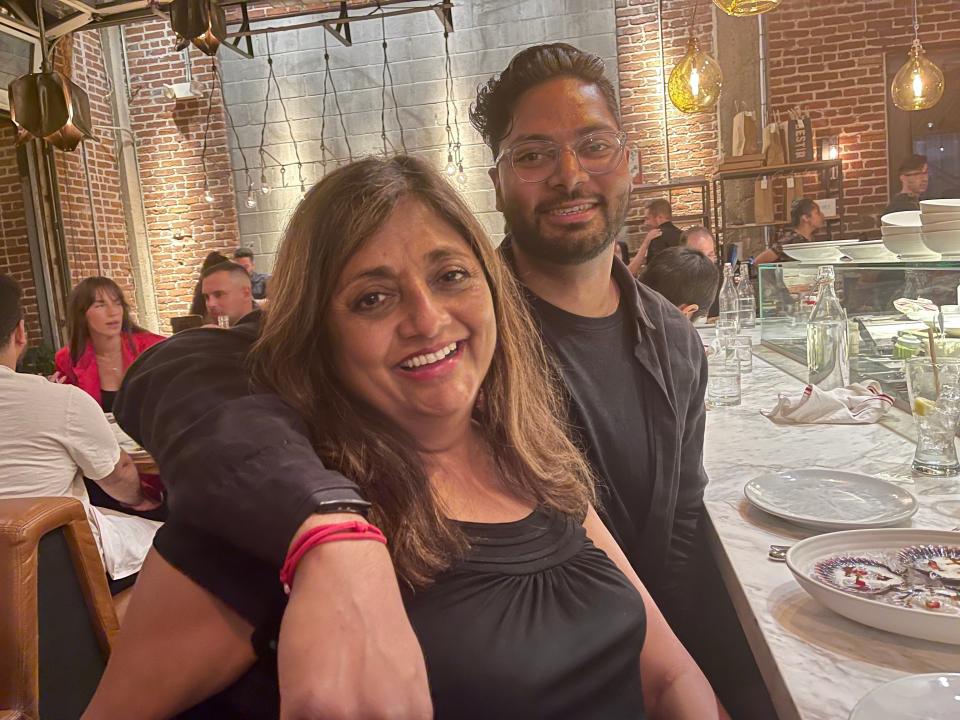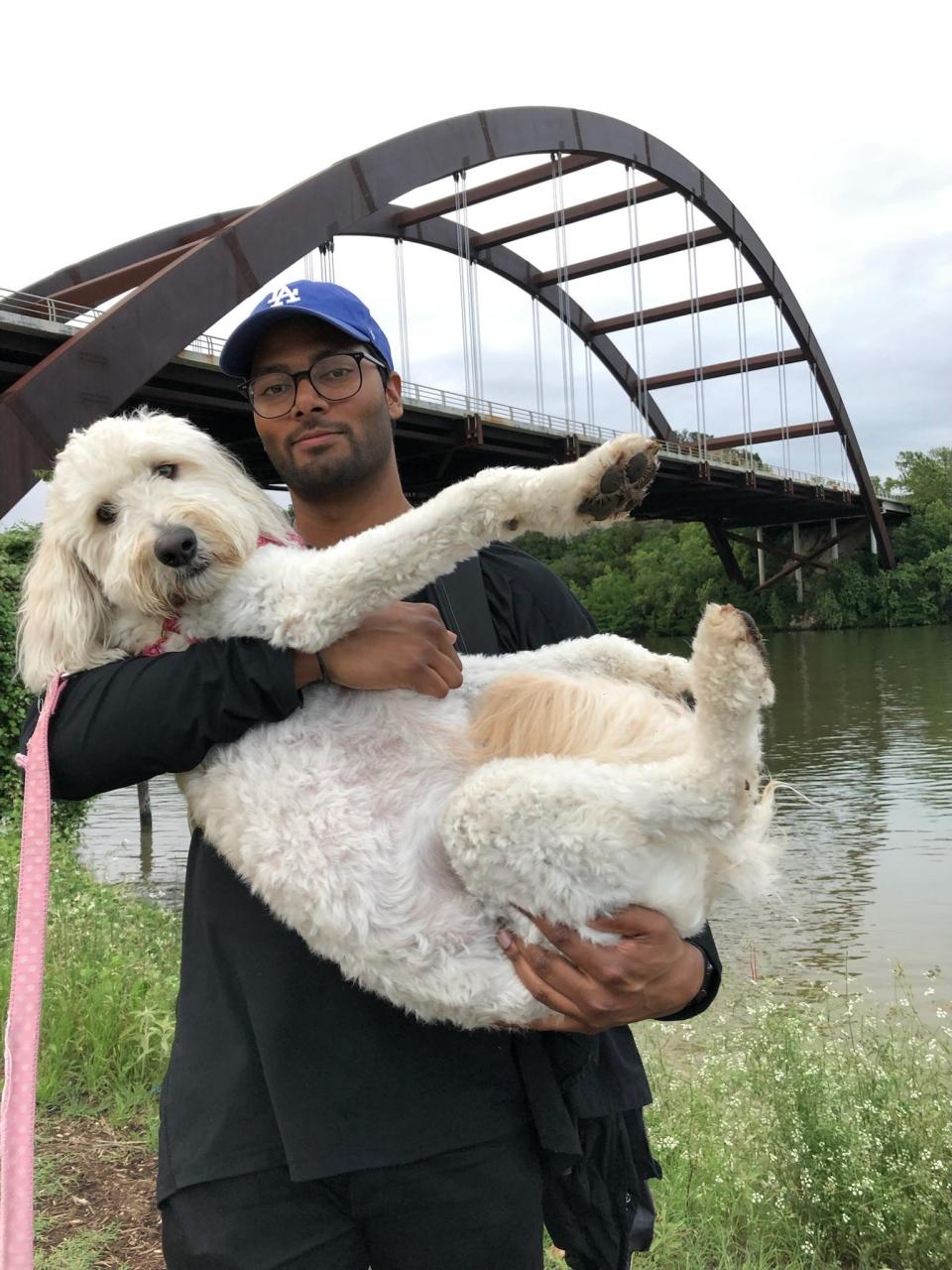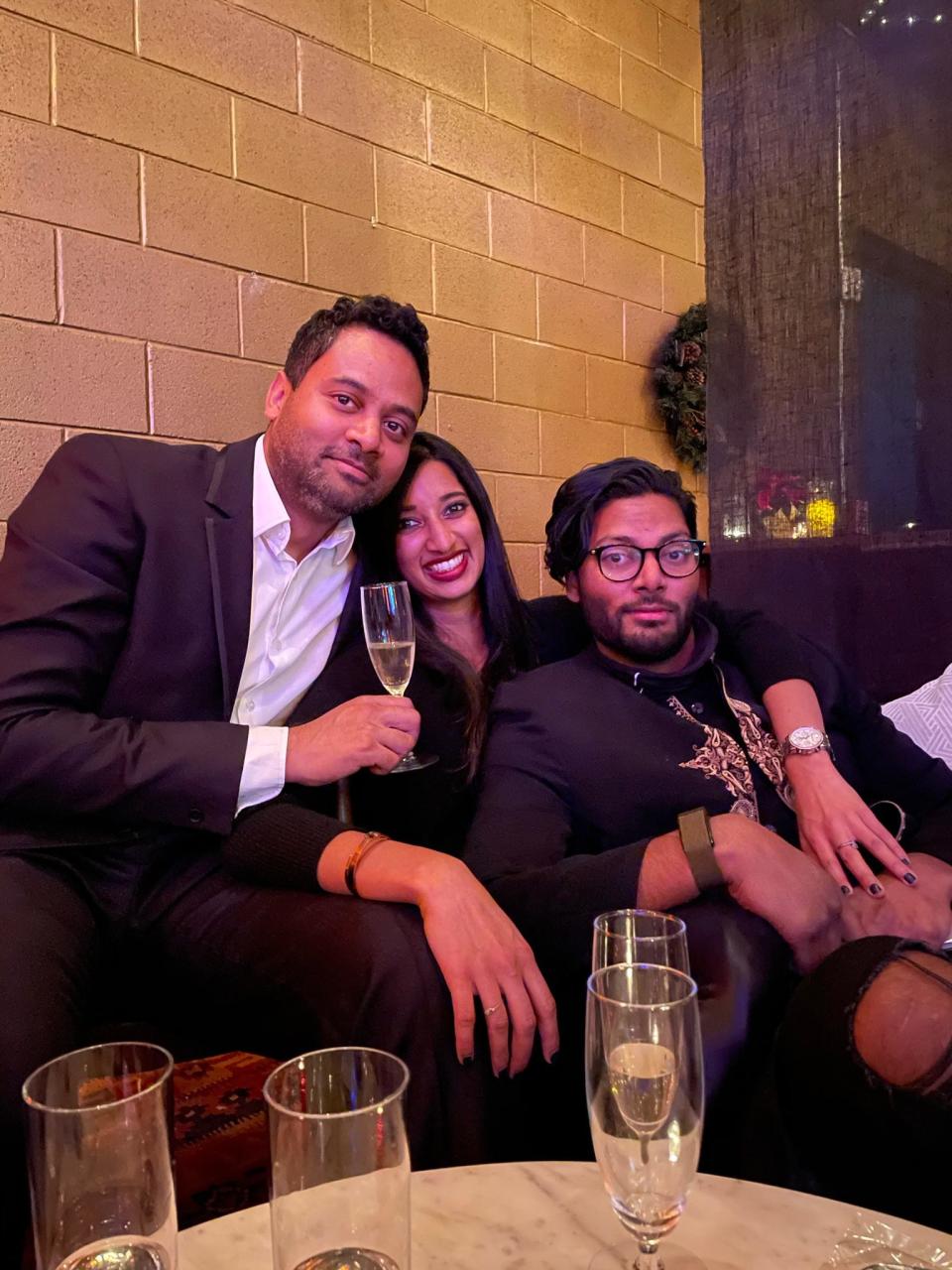Grumet: Rajan Moonesinghe was dying. Why was he in handcuffs?
A minute after firing five shots at Rajan Moonesinghe outside his South Austin home, police officer Daniel Sanchez pulled the bleeding man into handcuffs. It wasn’t easy.
The 33-year-old tech entrepreneur was curled up on his front porch, gunshot wounds in his chest, back, abdomen and thighs. His left arm was fractured near the wrist.
“Roll over on your stomach, buddy, so we can help you,” Sanchez said right after the Nov. 15 shooting, as Moonesinghe lay there, motionless.
“He’s having trouble,” officer Stephen Markert observed.
That’s about where the officers’ body camera footage cuts out, at least the portion of the video that the Austin Police Department publicly posted two months ago.
It's part of the evidence in the ongoing investigation into Moonesinghe's death, a tragedy rooted in a chain of critical events: Moonesinghe decided to confront an intruder instead of calling 911. He fired his rifle into his own house. A police dispatcher didn't tell officers that the armed man was the person who lived there. And, crucially, Sanchez opened fire before Moonesinghe had a chance to drop his weapon or explain himself.
Change any of those moments and this man could still be alive.

Now, Moonesinghe's family is raising new questions about the use of force in this case. Additional footage from Moonesinghe’s front porch security camera, which his family provided to the American-Statesman, shows that police kept the dying man in handcuffs for an agonizing six minutes.
Even when it was clear he posed no threat and needed medical attention.
At one point, the security camera footage shows, a female officer providing basic medical care says: "You have to uncuff him. You can't do CPR with him in cuffs."
But Moonesinghe remained handcuffed for an additional two minutes until medics arrived. Then a male officer said, “Take him out of cuffs, take him out of cuffs.”
Moonesinghe died a short time later at the hospital.
Citing the open investigation, the Police Department has declined to answer any questions about the Nov. 15 shooting, including my questions about the officers’ decision to handcuff Moonesinghe.
“The department respects the investigation and court process and will not make any further comments at this time,” police spokesman Brandon Jones said.
The Combined Law Enforcement Associations of Texas, or CLEAT, which represents Sanchez, also declined to comment. Sanchez just marked his third year on the force, with one positive performance review and no complaints in his public file. He remains on paid leave while the investigation plays out.
Moonesinghe’s older brother, Johann, obtained the front porch security camera footage from Ring. He has pored over all the video from that night, frame by frame, anguished and looking for answers.
“He clearly wasn't responsive at all, so why handcuff him?” Johann Moonesinghe asked. “And at that moment, (police) would have known that he was the homeowner and that they had shot the homeowner. Then why didn't they try to save him?”
“It’s not human to me at all,” he added. “It made me really, really, really angry when I saw that footage.”
Gifted and generous
Those who knew Rajan Moonesinghe — Raj — never expected his story to turn out this way. It's hard to square the final images of him, armed on his own doorstep, with the generous person family and friends knew.
Moonesinghe was a California native and finance whiz who worked his way through the University of San Diego by trading stock options, his brother told me. The brothers and two other partners co-founded inKind, an app that has provided upfront capital for more than 650 restaurants by selling food and beverage credits to more than 200,000 customers.

A foodie of Sri Lankan descent, Moonesinghe was developing his own restaurant called Ember, a modern steakhouse steeped in Latin flavors, slated to open soon in the Seaholm district. He brought over soup when friends were sick and dropped off burgers when his brother returned from business trips.
“I think hospitality was in his DNA,” said Johann Moonesinghe, recalling how his brother loved to grill meat and vegetables at their dinner parties. At the office, Rajan Moonesinghe made sure everyone felt welcome.

His family said Moonesinghe also wanted to develop a sustainable farming operation, alongside a school and medical clinic, on more than 200 acres he bought in Zambia, building on a passion for charitable work in Africa that began when he was in high school.
The brothers moved to Austin five years ago, figuring the tech hub would be a great place to grow inKind. They eventually settled two blocks from each other in the Bouldin Creek area, on streets where modern, two-story homes have been replacing midcentury bungalows at breathtaking speed.
Growing concerns over safety
Those million-dollar homes boast a coveted location near downtown. But the neighborhood has seen its share of break-ins and other crimes.
A woman who used to live across the street from Rajan Moonesinghe was held up at gunpoint in November 2020, as she returned home one night. Police took a report but never found the assailant.
“I was traumatized by that,” said the woman, who asked not to be identified because she is the victim of an unsolved crime. “I kept telling (family members) to make sure the doors are locked.”
In the spring of 2021, Johann Moonesinghe’s husband, inKind co-founder Andy Harris, discovered a rusted machete on top of their garbage can, shortly after neighbors posted on NextDoor about an agitated man walking around with such a weapon. Harris called police, who took the machete away.
And just over a year ago, another friend and inKind co-worker, El Khattary, was washing dishes after dinner when he saw a man scale his fence and roam through his backyard. His home is seven doors down from where Rajan Moonesinghe lived on South Third Street, just north of Oltorf Street.
“It kind of freaked us out,” Khattary told me. He thought about going out there with a knife, but his wife urged restraint. Yelling at the intruder was enough to chase him off.
“We were concerned this individual would come back at night,” Khattary said. “So obviously we had our alarm system on and our cameras going.”
His brother said Rajan Moonesinghe knew about those incidents and had his own concerns, as the duplex where he lived backed up to a wooded area frequented by people who are homeless.
In August 2021, Rajan Moonesinghe swapped out his doorbell camera for a porch security camera.
Last October, he bought a Daniel Defense DDM4 semi-automatic rifle with a 16-inch barrel. A friend helped him practice using the weapon at a gun range.
Shortly after midnight Nov. 15, Moonesinghe paced around his porch with that rifle. Security camera footage shows him telling a neighbor that there is an intruder in the house, outside the camera's view. In other moments, Moonesinghe issues orders to leave.
“Get out of my house,” he said at one point, growing exasperated. “Otherwise I’m going to shoot the (expletive) out of you, and I don’t want to.”
The 911 call came from a security guard hired by the neighbor across the street, where a sleek new home sits behind security gates.
A spate of unanswered questions
Even with the security camera footage, there are so many questions about that night.
For starters: Why didn’t Rajan Moonesinghe call police?
His brother suggested that maybe Moonesinghe couldn’t reach his phones because of where the intruder was standing. Also, the brother noted, "I don't know that minorities are comfortable calling the police for reasons that Rajan's death makes obvious."
As Moonesinghe stood armed outside that night, his neighbor asked if he had called police.
"I did not," he said, holding up his rifle, "because I have a nice big (expletive) gun."
A few seconds later, he adds, "I need to call the police."
Did something impair Moonesinghe's judgment? His brother said he had no history of mental health problems. We're still waiting for an autopsy report that will indicate whether he had been drinking. But the 911 caller said Moonesinghe appeared too coordinated to be intoxicated. When Johann Moonesinghe looks at his brother’s demeanor on the video footage, “I think he’s really scared.”
What about the intruder? Police found no one inside when they got there. It's unclear whether someone could have slipped out the back door. Moonesinghe believed someone had broken into his house before: When he returned from a trip the previous day, he told his mother, his bedspread was missing and other items had been moved around.
Other central questions revolve around the police response.
The 911 caller told dispatchers that the man with the gun was at his own house and that he might be having a mental health issue. “He almost seems to be scared of something inside of his home,” the caller told dispatchers.
Yet that information was not relayed to officers headed to the scene. According to a recording of police radio traffic, officers were only told there was a man who pointed a rifle toward the street. The dispatcher started to provide another detail — that the armed man was turning the house lights on and off — when an officer cut in to announce shots had been fired.
Indeed, Sanchez immediately opened fire as he finished shouting, "Drop the gun!" Why didn’t he give Moonesinghe a chance to comply? Officers have been trained in de-escalation techniques, and the video shows Moonesinghe never raised his gun toward police.
And, once Moonesinghe was critically wounded by multiple gunshots, why was he handcuffed?
As he struggled to remain conscious, with officers repeatedly telling him to “stay with us,” why did he remain in handcuffs?
A source of soul-searching
It’s Austin police policy to handcuff a person being taken into custody, even when that person is injured. Several experts told me that’s standard practice. The suspect could turn combative or try to escape.
Still, officers are supposed to use discretion. The Police Department’s General Orders say that “the officer will consider the prisoner's special circumstances before applying any restraining device.”
The policy adds: “The prisoner should not be restrained in such a way that proper medical attention is prevented.”
Jesse Porter, a retired lieutenant from the Washington, D.C., Metropolitan Police Department who now serves as an instructor and consultant, said officers are trained to secure the scene by handcuffing suspects. Once they have a better read of the situation, though, they should reassess whether restraints are needed.
“The subject in this situation was severely injured (and) probably didn’t require handcuffing,” Porter told me.
He also noted that an officer’s adrenaline is pumping after a shooting. It’s incumbent on the supervisor arriving on scene to look at the situation with fresh eyes.
In trainings conducted with other police departments, Porter tells them, “If you see (a person) doesn't require restraints, you tell them to take them off.”
Chuck Wexler, executive director of the Police Executive Research Forum, noted that the Austin police policy allows for discretion. The challenge is teaching officers how to exercise it.
This is a conversation happening at police departments around the country, after other high-profile cases of people left in handcuffs as they were dead or dying.
“Some departments are revisiting the circumstances under which you would handcuff someone,” Wexler told me. “There’s a lot of soul-searching going on as to how you balance the threat officers may face from an individual with the sanctity of human life in getting that person treated.”
It’s impossible to say whether Moonesinghe would have survived without the handcuffs. His gunshot wounds were severe, according to a preliminary autopsy ordered by the family.
But the restraints needlessly added to the pain of his final moments. And they represent one more area where the grieving family wants to see change — not because anything could bring Moonesinghe back. But because no one else should suffer that same way.
Grumet is the Statesman’s Metro columnist. Her column, ATX in Context, contains her opinions. Share yours via email at bgrumet@statesman.com or via Twitter at @bgrumet. Find her previous work at statesman.com/news/columns.
This article originally appeared on Austin American-Statesman: Rajan Moonesinghe was dying. Why was he in handcuffs?

